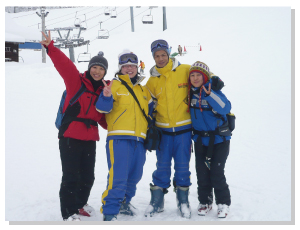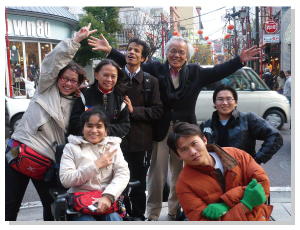- HOME
- Alumni News
- Vu Thuy Linh (9th trainee)
- Linh's Final Report
Linh's Final Report
Final Report
The reason for coming to Japan
In Viet Nam, I was teaching at a deaf school while instructing sign language at Hanoi Association of the Deaf where I belong. I wanted to learn these three things in Japan.
(1) Improving education for the deaf: in Viet Nam, school lessons are generally given vocally and there is only one school that offers sign language classes. And even this school does not give good enough instructions. It is also very difficult for deaf people to receive higher education and most of them have only primary school education. I had always strongly felt it important to stress the need of education for the deaf.
(2) Strengthening deaf organizations: there is no integrated national deaf organization in Viet Nam. Hanoi Association of the Deaf, the organization where I belong, does recognize the need to understand the situation surrounding the deaf. However we do not have any concrete idea or means and activities remain low. We also have a shortage of skilled people, with adequate knowledge or experience.
(3) Training of sign language interpreters: I was an instructor at seminars that aimed to train sign language interpreters. Allegedly there are only 17 sign language interpreters in Viet Nam so the training cannot wait. However, the students learning speed is slow. We did not have any solid curriculum either so we were always unsure if our way was the best way. This was why I was highly keen to see how sign language interpreters were trained in Japan.
Japan for the first time and my first experiences
The thing that struck me most when arriving in Japan, was the highly developed public transport system. Stations were sign-posted very well so it was very easy to go to places.
Japanese culture was also highly interesting. It was a delight to see ancient temples and castles, plum and cherry trees, and very touching to attend shodo and kado classes—the art of Japanese calligraphy and flower arrangement—or a tea ceremony wearing a kimono, all of which were traditional Japanese practices. I also noticed that the New Year cuisine in Japan was entirely different from that of Viet Nam, when I visited Iwabayashi-san’s home for my home-stay program.
I also challenged skiing and swimming for the first time in my life. Swimming was scary at first, but once I got the hang of it, it was a lot of fun. Skiing is also something that is not possible in Viet Nam, so I enjoyed it to the best of my abilities. I fell over countless times, but the pain was eased by a hot spring.

Individual training
We spent three months studying Japanese and Japanese sign language before the individual training programs. The language training was crucial in order to have a fulfilling individual training experience, but I had never studied Japanese or Japanese sign language until I set foot in Japan. The teachers guided us wonderfully however, so I managed to enjoy studying it. I especially enjoyed studying kanji--- the more complex system of Japanese notation, aside from basic alphabets—which was very intricate and interesting. I would like to continue studying Japanese and kanji even after I go back to Viet Nam.
1. Deaf education
I attended a training program at Tokyo Metropolitan Chuo School for the Deaf under the guidance of Mr. Hashimoto and other teachers. I also enjoyed the opportunity which they kindly granted me, to teach painting and Viet Nam cuisine to the students. The school had junior high and high school departments where teachers were enthusiastically engaged in instruction. When I saw this, I felt that it was important to improve junior high and high school education in Viet Nam for the deaf people in Viet Nam to go to university.
I attended Mr. Osugi’s lecture at Tsukuba University of Technology. It included sign language and court cases where deaf people fought for their rights, which helped me to understand the history of Japan’s deaf movement. I found Remote Sign Language Interpretation System amazing. It is a system where the class of deaf students and another location with sign language translators are connected via the Internet so that information can be shared. With this system, one does not need expert sign language interpreter on-site; with this system, specialized university-level classes can always be helped with a sign language interpreter irrespective of location. I understood the importance of information access for the deaf, and conversely, that deaf people can receive education IF there is access to information
2. Organizations of the deaf
I went to Japanese Federation of the Deaf and Fukuoka Prefectural Center for the Deaf. At Fukuoka Prefectural Association for the Deaf, I was given an orientation of the facility, its services and how they send out sign language interpreters. I was stunned to see such a good facility at a regional level.
Just like Japanese Federation of the Deaf, which is a national organization, the Prefectural Association also had many departments with different activities. I participated in the activities of women’s department where they held regular meetings and other recreational activities.
The most inspiring event in Fukuoka was the sign language classes for middle-aged to senior participants. These participants were learning sign language to be able to communicate, and not looking to become professional sign language interpreters. In Viet Nam there are very few middle-aged/senior people who can use sign language, and many people also have presumptions that unless one is young, it is too hard to learn a sign language. I felt that it would be extremely beneficial for deaf people, if many generations showed interest and tried to learn sign language.
At Japanese Federation of the Deaf, I learned about Japan’s deaf movement and the welfare system concerning the deaf. The Federation offers support to deaf people if they are hit by earthquakes or other calamities. This alone shows the importance of having an integrated, national organization of / for the deaf, and of the metropolitan and regional offices to work together with frequent communication. Since Viet Nam has economic issues and a lack of good public transport, it is difficult for, say, deaf people in Hanoi and Ho Chi Minh to interact. It encouraged me to see that in Japan—a country that has the land stretching from far north to the south, just like Viet Nam—organizations of the deaf were so close-knitted. I would like to tell my friends in Viet Nam how important it is for deaf people in Viet Nam to work together on a national level.
I was also deeply touched to see the activities of young people’s department. They were fundraising, holding regular meetings and printing publications to keep their activities going. I learned the method to support deaf people by attending this department’s classes. There are very few young people’s departments in Asia-Pacific countries. Our Association in Hanoi does have a young people’s department but they are not engaged in any tangible activities. For the next generation of the deaf, I feel that the young generation like ourselves should be more actively involved in deaf movement.
3. Training of sign language interpreters
Training of sign language interpreters is the area I would like to devote myself most to. Of the 10 month training I had, the training at the Diploma Course for Sign Interpreters at College, National Rehabilitation Center for Persons with Disabilities (Saitama Prefecture) was most inspiring for me. The course has a period of two years. In the first year, students learn sign language without resorting to the Japanese language—so that students can learn to think in sign language. Until then I had been teaching my students in Viet Nam by explaining the sign language in Vietnamese. I clearly understood why sign language students in Viet Nam took so long to learn. Under Mr. Kosonoe’s guidance, I had a mock class to teach Vietnamese sign language, which was not very easy. I would like to remember and use this experience for my activities in Viet Nam.
In the second year, students have more time to polish up their interpretation skills. Teachers are very disciplinary and pay attention to smallest detail, but because of this students get better quickly.
It was also most inspiring to see that the interpreters continued to train themselves to maintain or improve their skills even after they had become professionals. They were helped by deaf people and other experienced sign language interpreters. For example, if a deaf person expresses something while not looking towards the interpreter, the interpreter would remember the information and interpret it later. They were also learning the ways with which to direct the deaf person’s attention towards the interpreter during seminars and presentations. I understood that sign language interpretation was not just an art of translating sign language into Japanese or Japanese into sign language, but that it requires a lot more, perfected skills as an interpreter. In Viet Nam, deaf people tend to feel satisfied just by having a sign language interpreter available, and rarely have an objective evaluation of the interpreter. I felt that it was also deaf people’s responsibility to change the way they think, if we wanted to nurture highly skilled, professional sign language interpreters.

My thoughts on the training
Through the variety of training programs in Japan, I painfully recognized how much more had to be done for / by deaf people in Viet Nam. There are many differences between the activities of deaf people in Viet Nam and Japan. In Japan, deaf people’s awareness of their rights was prominent. On the contrary, most of deaf people in Viet Nam are not aware that they too have the same rights as non-deaf people.
Driving license is also essential for participation and job opportunities of deaf people, but in Viet Nam, deaf people are not allowed to have a driving license. After I learned the history of Japanese deaf people and their driving licenses, I feel it very important for deaf people to speak out.
The same can be said about sign language interpreters. If deaf people begin to understand that they can, or rather should, have a critical opinion if an interpreter is not equipped with adequate skills, it will have a significant impact on the quality of information access for deaf people.
My goals after returning to Viet Nam
I would like to start and develop many activities at Hanoi Association of the Deaf. There are many things that the association would like to accomplish; creating a national organization of the deaf, and preparing a foundation for higher education for the deaf. I would also like to look for ways for deaf people to obtain driving licenses, by gathering their voices and submitting a request to the government. But first of all, I would like to get on with sign language interpreter training. In Hanoi, there are only four sign language interpreters at present. I would like to use what I learned at College, National Rehabilitation Center for Persons with Disabilities, to find ways most suited to Viet Nam to train sign language interpreters.
Lastly
Before coming to Japan I was very anxious and had many worries but I learned so much in Japan. Chairman Mr. Ito and everyone at the Duskin Ainowa Foundation, everyone at Japanese Society for Rehabilitation of Persons with Disabilities, and Mr. Komai, Ms. Sagara and Ms Nasu, thank you for choosing me for the program.
I will use everything I learned in Japan for my future and do my best in Viet Nam!





